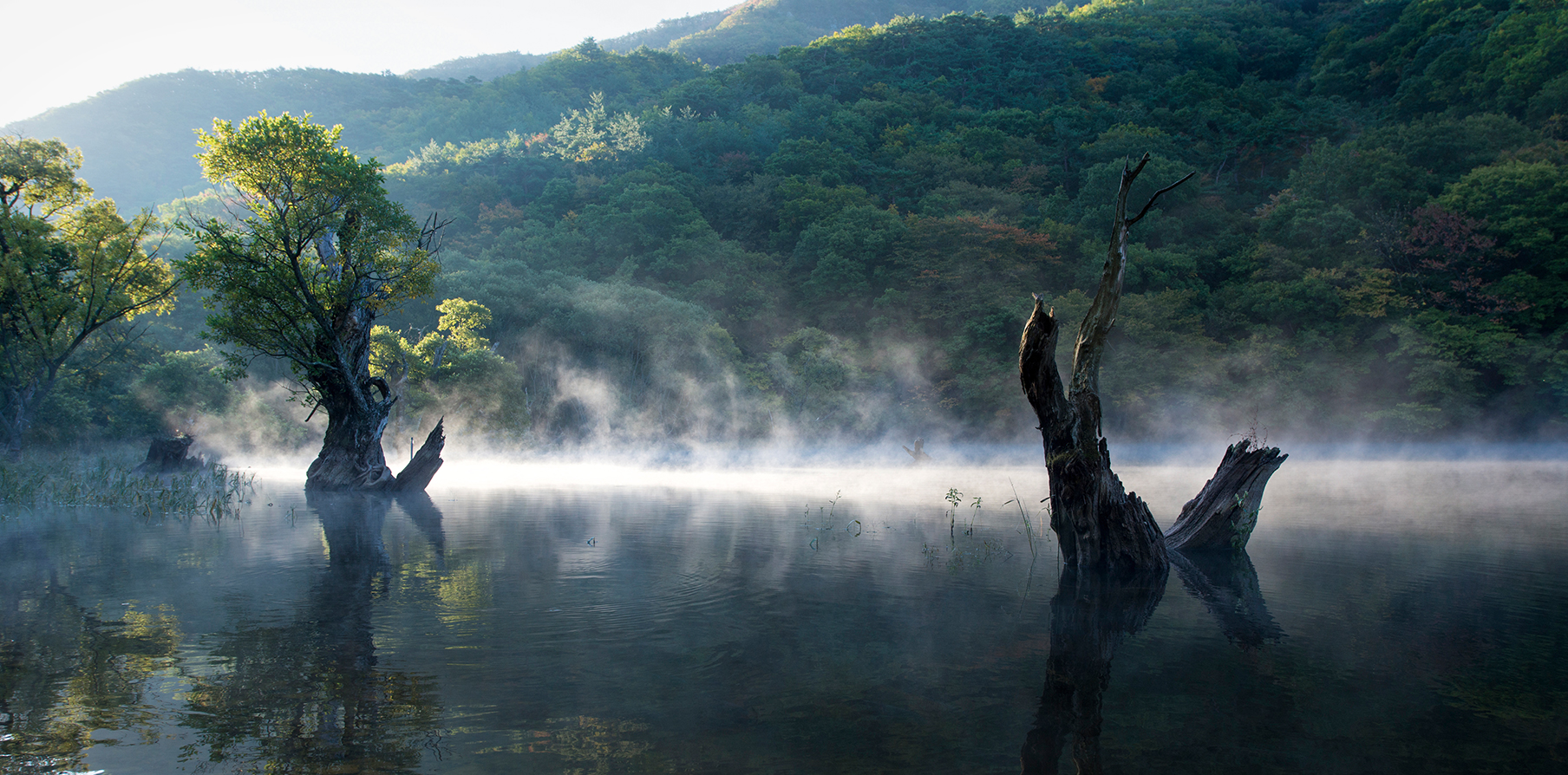Travel
Forged by Nature
Cheongsong UNESCO Global Geopark
Cheongsong-gun County, Gyeongsangbuk-do Province, houses the ultimate immersive experience in forest land. Eighty percent of the county’s terrain is mountainous, but the region is also famous for its sweet apples and even sweeter views. Indulge in the wonders of Mother Nature from Jusanji Pond cast against the glimmering horizon and Neogu Maeul Village, where Juwangsan Mountain’s streams converge to the bizarrely shaped rocks comprising Cheongsong UNESCO Global Geopark.
Written & photographed by• Cho Yongsik
Approaching Jusanji Pond in the wee hours of dawn is exciting for both novice and seasoned trekkers. Red leaf willows give way to wet fog on mornings during the temperate seasons of autumn and spring. A dead willow submerged in the waters is an enchanting sight. Green hues imbue the water, adding a refreshing tint to its surrounding foliage. Dewy mornings such as these give way to a hazy solar halo.
Spotless Terrain
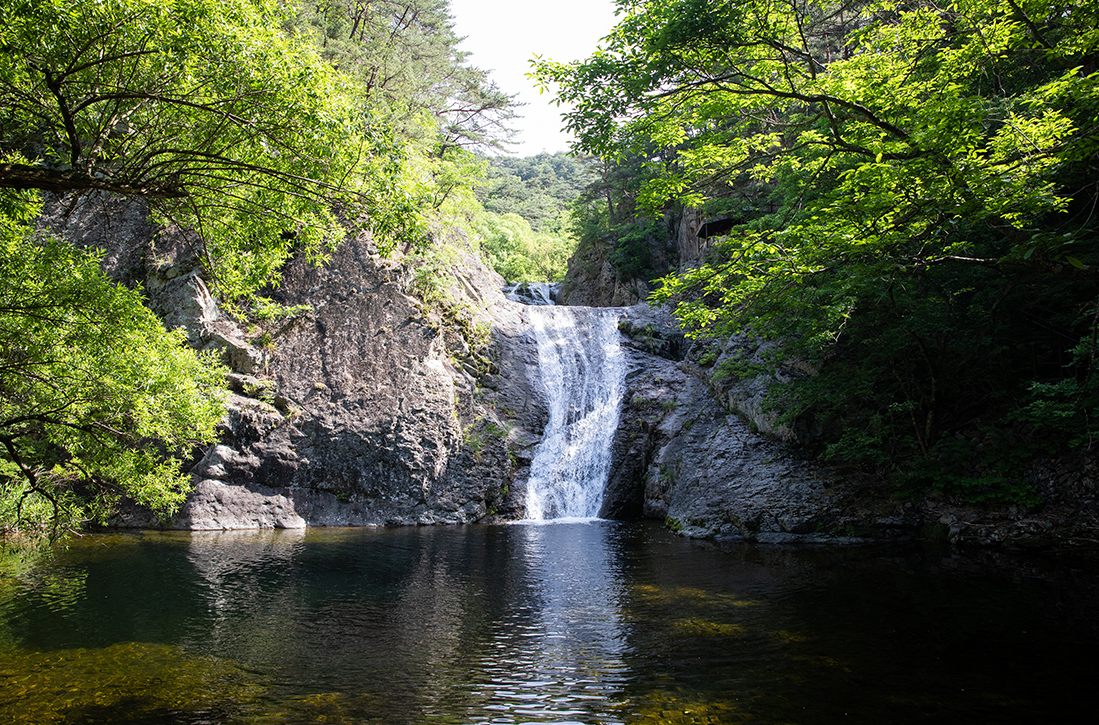
Jusanji Pond, where Cheongsong Geopark’s streams intersect, glistens at sunrise. © Shin Jung Sic
Jusanji Pond never dries up even during the worst droughts. Constructed in October 1720, the petite reservoir is 8 m deep, 200 m long and 100 m wide, and at its center are around 30 red leaf willows aged 200-300 years.
Guides are posted throughout Juwangsan National Park to remind visitors of “distanced trekking manners,” including staying at least 2 m away from others, wearing masks, washing hands and refraining from staying in one spot too long. Walking from Daejeonsa Temple and past Juwangam Hermitage, Yongchu Falls, Yongyeon Falls and Geumeungwangi Samgeori (Three-way Intersection) brings one to Neogu Maeul Village in Woloe-ri. The village is connected not only to the clear horizon, but also four streams, and houses four mountain intersections. The refreshing panorama of aquatic falls is proof positive of Mother Nature’s presence.
Dalgi Mineral Spring Site awaits on the way down. The mineral water spewing from rock crevices tastes like soft drinks, an unlikely trait for iron-rich liquid. Those hesitant to taste it raw can add yeot (taffy) provided at the spring. The water brings a sapphire tint to rice when used for cooking and eliminates the foul odor in baeksuk (whole chicken soup). For that reason, many restaurants serve baeksuk at the vicinity. Solgi Hot Spring Site is well known among spa aficionados for its high quality water, with its pristine springs flowing out of aquifers from 710 m underground and relaxing like no other.
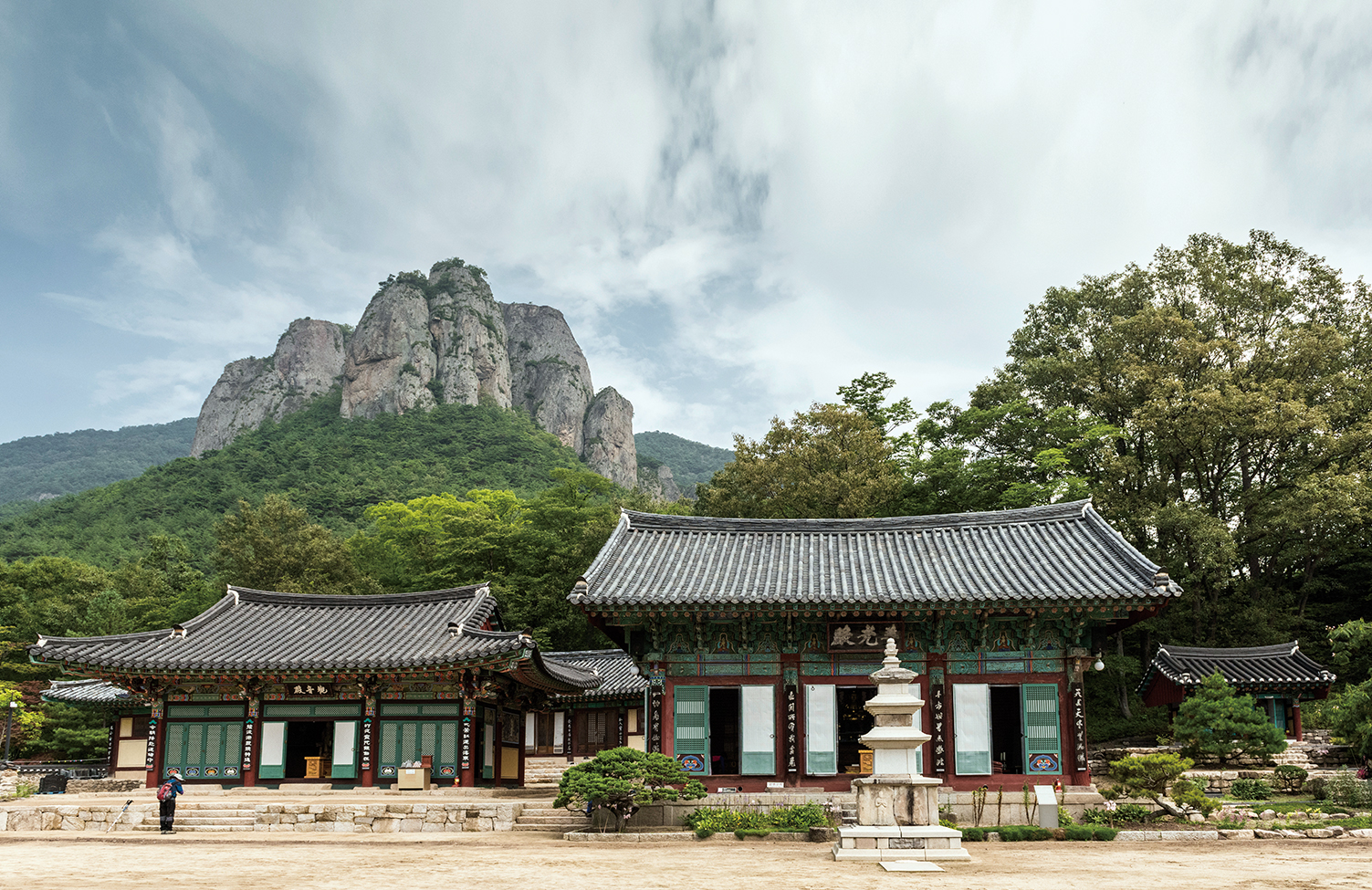
Bogwangjeon Hall of Daejeonsa Temple (National Treasure No. 1570) in Cheongsong-gun County, Gyeongsangbuk-do Province, is prized for both its aesthetic interior and rich history. © pixta
Geological Asset
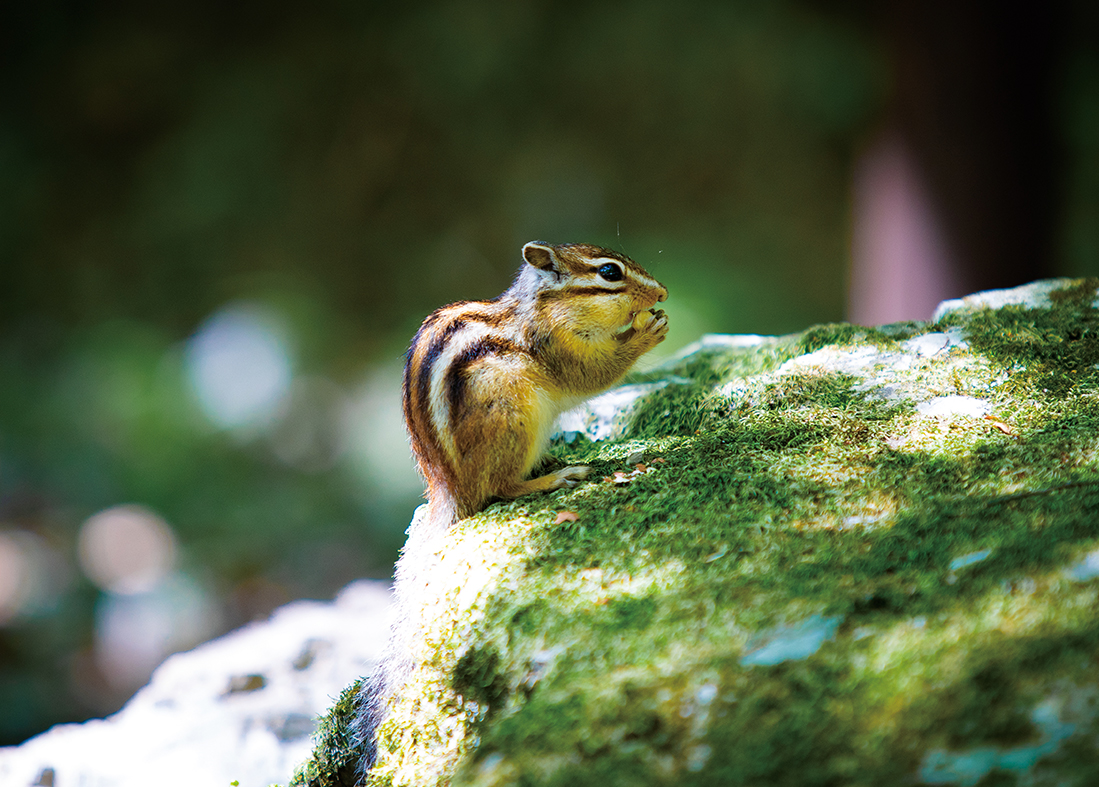
A wee squirrel basks in untarnished greenery. © Shin Jung Sic
Cheongsong-gun has no tropical nights, even at peak summertime. Thus Sinseong Falls is an extremely popular spot for visitors. Designated a Geopark both by the county and UNESCO, Sinseong comprises sedimentary rocks that underwent geological erosion and weathering.
Banghojeong Pavilion, an incised meander stream, greets visitors approaching from the falls’ info center. The stream’s inlayed curvature gushes and the pavilion are cast against a slanted cliff, shaped as such back in the Cretaceous Period. During the Joseon Dynasty, scholar Bangho Jo Joon-do is said to have built the pavilion to pay tribute to his deceased mother and devote himself to study. About 400 m from the pavilion in the village of Sinseong-ri are dinosaur track-bearing deposits, with fossils of sauropods and theropods visible to the naked eye.
A highlight of Sinseong is the beautifully shaped Mananjaam Cliff. Choi In-suh, a Geopark tour guide, said, “Mananjaam Cliff exhibits a different hue depending on the time of day,” adding that “marsh snails inhabit the streams underneath the reddish rocks.” Five minutes away at Baekseoktan Stream Valley are camping facilities.

Yongchu Gorge is the highlight of the hiking trail on Juwangsang Mountain, where a pathway is flanked by massive rock structures. © Shin Jung Sic
Nature’s Artwork

Core elements of Kim Jooyoung’s epic novel “Gaekju (The Gatekeeper)” are well-represented at Gaekju Literary House.
Another landmark at the falls is Baekseoktan Stream Pothole, where eroded and weathered potholes offer remarkable sights of geological phenomena. Baekseoktan stands for “Stream of Shiny White Stone” that is literally defined by sedimentary processes and include pelite fragments, cross bed and bioturbation. Tourists often perch themselves on smooth stone surfaces to gaze at the falls and streams.
A can’t-miss item here is “Refreshing Great Clouds (Cheongryangdaeundo)” by the late artist Yasong Lee Won Jwa (1939-2019), a colossal landscape painting. Inspired by Cheongnyangsan scenery, the artwork is 46 m long and 6.7 m tall. True to its name, Cheongryangdaeundo Gallery is built for the sole purpose of housing the eponymous piece. A second-floor viewing spot lets visitors appraise the life-size painting of the mountains as if they were there.
Other attractions of the county include Gaekju Literary House and Cheongsong Flower Stone. The stone refers to the vivid imagery of sunflowers, roses, chrysanthemums and peonies of its spherulite structure attributed by natural causes. The literary house, which honors Kim Joo-young’s eponymous historical novel “Gaekju (The Gatekeeper),” displays his writing tools, initial drafts and original copies of documents surrounding his greatest literary work.
“Tourists perch on smooth stone surfaces
to gaze at the falls and streams.”
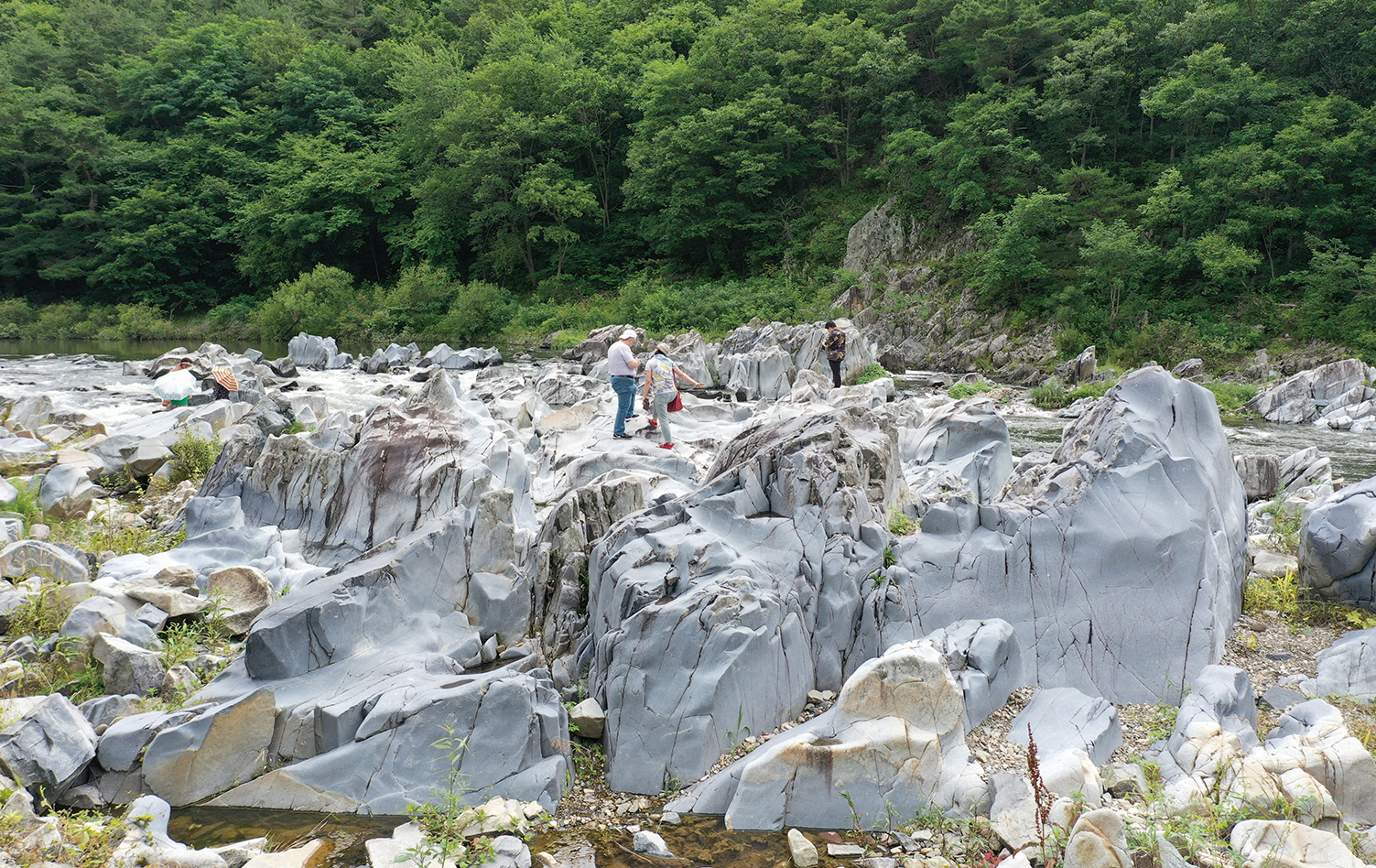
The Baekseoktan Rocks comprise one of Juwangsan’s wondrous surroundings.

